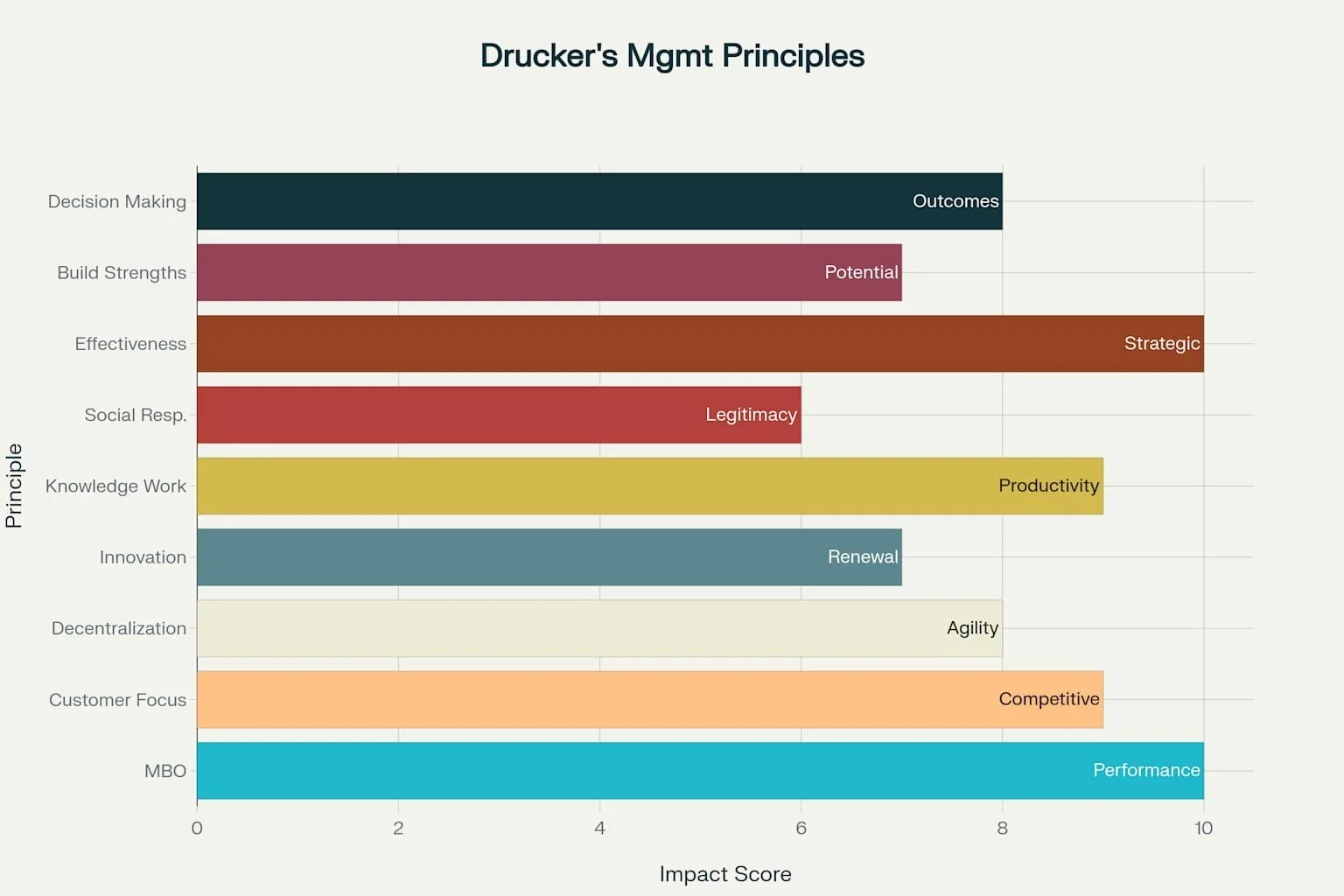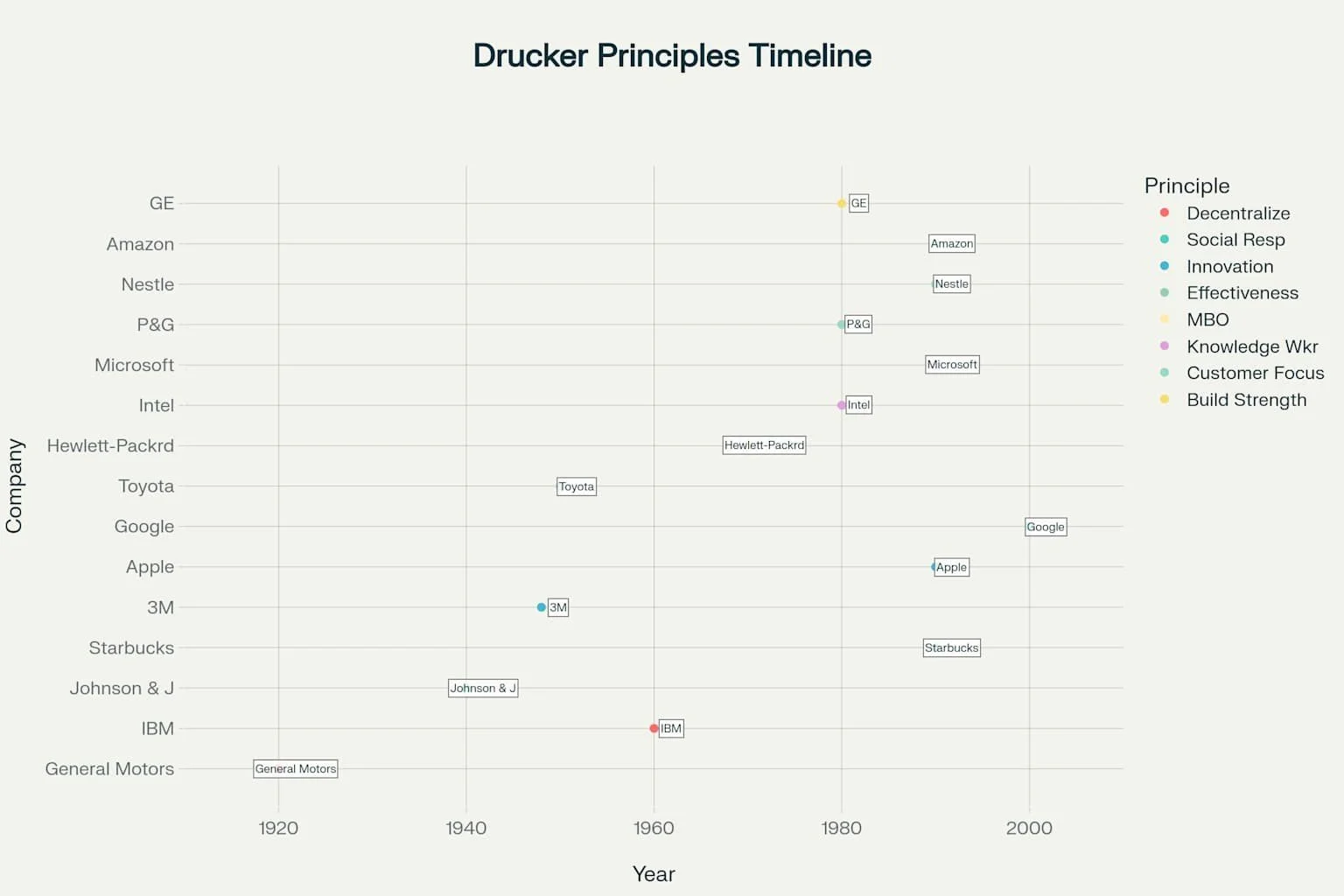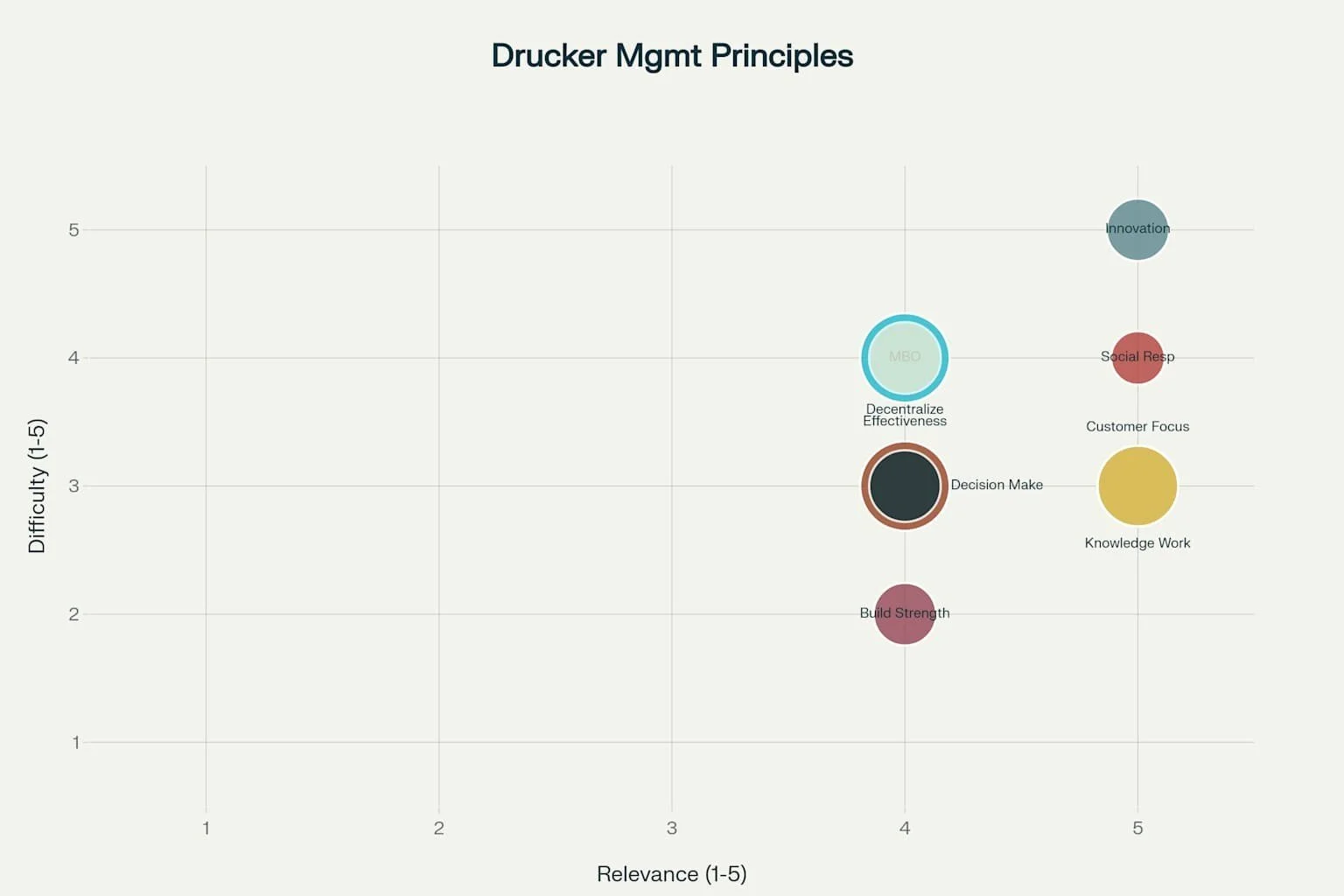Drucker’s Timeless Wisdom for Modern Business
Old tree in winter
Peter Ferdinand Drucker (1909-2005), widely recognized as the "Father of Modern Management," fundamentally transformed how organizations approach leadership, strategy, and operations. His extensive body of work spanning 39 books and countless articles established the foundation for modern management theory and practice. This comprehensive analysis examines Drucker's core management principles, their real-world applications across major corporations, and their enduring strengths and limitations in contemporary business environments.
Core Management Principles Overview
Drucker's management philosophy encompasses nine fundamental principles that have shaped organizational theory and practice for over seven decades. These principles represent a holistic approach to management that emphasizes human potential, customer value creation, and organizational effectiveness over mere efficiency.
Peter Drucker's Core Management Principles ranked by foundational impact on modern management theory
Management by Objectives (MBO)
Principle Foundation
Management by Objectives, first introduced in Drucker's seminal 1954 work "The Practice of Management," represents one of his most influential contributions to management theory. MBO establishes a strategic management approach where organizational performance goals are aligned with individual employee objectives through participative goal-setting processes.
Corporate Applications
Hewlett-Packard pioneered MBO implementation in the 1970s, creating systematic goal-setting processes cascaded through organizational levels. The company claimed this approach led to significant financial performance improvements and enhanced employee alignment. Intel has utilized MBO principles since the 1980s, particularly in their technology development cycles, contributing to their leadership in semiconductor innovation.
Strengths and Limitations
Key Strengths: MBO provides clear goal alignment, enhanced employee motivation, measurable outcomes, participative management approaches, and improved organizational accountability. The system encourages employee participation in decision-making processes, leading to increased commitment and performance.
Primary Weaknesses: Critics identify rigid goal-setting processes, short-term focus that may undermine long-term strategic thinking, potential for gaming the system, significant administrative burden, and inflexibility when adapting to changing circumstances. W. Edwards Deming notably criticized MBO for encouraging workers to meet targets through shortcuts that compromise quality.
Customer Focus and Orientation
Principle Foundation
Drucker's customer-centric philosophy asserts that "the purpose of business is to create a customer". This principle emphasizes understanding customer needs as the primary driver of business strategy, innovation, and competitive advantage.
Corporate Applications
Procter & Gamble has exemplified customer focus since the 1980s through extensive market research and customer-centric product development, achieving market leadership across multiple consumer categories. Nestle demonstrates this principle through continuous market research and adaptation to local customer preferences, enabling global market presence with local adaptation. Amazon has built its entire business model around customer obsession and data-driven decision making, leading to market dominance in e-commerce and cloud computing.
Strengths and Limitations
Key Strengths: Customer focus drives market responsiveness, creates sustainable competitive advantage, promotes long-term business sustainability, serves as an innovation catalyst, and generates consistent revenue growth. Organizations adopting this principle demonstrate superior adaptation to market changes and customer preferences.
Primary Weaknesses: Implementation can create internal conflicts between departments, presents resource allocation difficulties when balancing customer needs with operational efficiency, involves short-term costs for long-term benefits, faces implementation challenges in complex organizations, and may generate stakeholder conflicts.
Decentralization and Employee Empowerment
Principle Foundation
Drucker advocated for decentralized management structures that delegate authority and empower employees at all organizational levels. This principle, detailed in his 1946 work "Concept of the Corporation," emphasizes creating smaller, autonomous teams where individuals feel capable of making meaningful contributions.
Corporate Applications
General Motors pioneered coordinated decentralization from the 1920s through the 1960s under Alfred P. Sloan's leadership, achieving successful multi-brand strategy and market expansion. IBM implemented autonomous business units with delegated decision-making authority from the 1960s through 1980s, improving agility in technology transitions. Modern applications include remote work structures and agile organizational designs that emphasize distributed decision-making.
Strengths and Limitations
Key Strengths: Decentralization enables faster decision-making, enhanced employee empowerment, innovation stimulation, organizational flexibility, and improved local responsiveness to market conditions. Employees experience greater job satisfaction and engagement when given authority over their work.
Primary Weaknesses: Organizations face coordination difficulties, potential loss of centralized control, inconsistent standards across units, communication gaps between departments, and role confusion among employees. Balancing autonomy with organizational coherence remains a persistent challenge.
Innovation and Systematic Abandonment
Principle Foundation
Drucker emphasized that innovation requires "organized abandonment" and "creative destruction" of obsolete practices, products, and processes. He advocated for systematic evaluation of all business activities every three years, asking whether current practices would be initiated today given present knowledge.
Corporate Applications
3M exemplified this principle through their "15% time" policy allowing employees to pursue personal projects and systematic product portfolio reviews, resulting in breakthrough innovations like Post-it Notes. Apple demonstrates innovation through breakthrough product development and deliberate abandonment of unsuccessful products, creating revolutionary products that establish new market categories. Google implements "20% time" for innovation projects within flat organizational structures, generating continuous streams of innovative products and services.
Strengths and Limitations
Key Strengths: Systematic innovation approaches enable continuous organizational renewal, optimize resource allocation, maintain competitive edge, enhance adaptability to market changes, and provide strategic focus on future opportunities. Organizations practicing abandonment avoid resource waste on declining initiatives.
Primary Weaknesses: Implementation faces significant resistance to change, emotional attachment to existing products and processes, substantial implementation costs, disruption risks during transition periods, and cultural barriers to abandoning successful past practices. Organizations often struggle with timing decisions about when to abandon profitable but declining initiatives.
Knowledge Workers and Intellectual Capital
Principle Foundation
Drucker coined the term "knowledge worker" in his 1959 book "Landmarks of Tomorrow," predicting that knowledge would become the primary asset of 21st-century institutions. Knowledge workers are individuals whose value derives from expertise, problem-solving abilities, and creative thinking rather than manual labor.
Corporate Applications
Microsoft has built its success on knowledge worker empowerment and collaborative development platforms, achieving dominant positions in software and cloud services. Intel emphasizes hiring and developing technology knowledge workers, maintaining leadership in semiconductor innovation and talent retention. Google and other technology companies structure their organizations around knowledge worker productivity and innovation capacity.
Strengths and Limitations
Key Strengths: Knowledge workers drive higher value creation, build intellectual capital, enhance innovation capacity, contribute to economic growth, and provide sustainable competitive advantages. Organizations investing in knowledge workers demonstrate superior adaptation to technological change.
Primary Weaknesses: Organizations struggle with productivity measurement for knowledge work, face retention challenges in competitive markets, encounter management complexity when supervising autonomous knowledge workers, incur significant cost implications for talent acquisition and development, and confront skills obsolescence in rapidly changing fields.
Social Responsibility and Stakeholder Capitalism
Principle Foundation
Drucker differentiated between two types of corporate social responsibility: social impacts (what business does to society) and social problems (what business can do for society). He argued that while profits are necessary, they should not be the sole goal of business.
Corporate Applications
Johnson & Johnson exemplifies social responsibility through their Credo-based decision making that integrates stakeholder responsibilities, maintaining sustained reputation and stakeholder trust since the 1940s. Starbucks demonstrates comprehensive social responsibility through employee benefits and community engagement programs, achieving strong brand loyalty and employee satisfaction.
Strengths and Limitations
Key Strengths: Social responsibility builds stakeholder trust, ensures long-term organizational legitimacy, provides risk mitigation, enhances brand reputation, and increases employee engagement. Organizations with strong social responsibility records demonstrate greater resilience during crises.
Primary Weaknesses: Implementation requires careful cost-benefit balance, creates potential stakeholder conflicts, presents measurement difficulties for social impact, may create competitive disadvantages in short-term financial performance, and diverts resources from core business activities.
Effectiveness Over Efficiency
Principle Foundation
Drucker's famous distinction between "doing things right" (efficiency) and "doing the right things" (effectiveness) emphasizes strategic clarity over operational optimization. He argued that effectiveness—achieving the right objectives—is more important than efficiency in task execution.
Corporate Applications
Toyota exemplifies this principle through just-in-time production and continuous improvement (Kaizen), achieving industry-leading quality and efficiency standards. Their approach focuses on doing the right activities rather than simply optimizing existing processes. The principle underlies modern strategic prioritization frameworks and data-driven decision making.
Strengths and Limitations
Key Strengths: Effectiveness focus provides strategic clarity, optimizes resource allocation, delivers better outcomes, enhances goal achievement, and improves priority setting across organizational levels. Organizations emphasizing effectiveness demonstrate superior long-term performance.
Primary Weaknesses: Implementation presents difficulties in distinguishing effectiveness from efficiency in practice, involves subjective assessment of "right" activities, may create analysis paralysis, encounters resistance to changing established processes, and faces challenges in defining effectiveness metrics.
Building on Strengths
Principle Foundation
Drucker advocated focusing on individual and organizational strengths rather than attempting to fix weaknesses. He believed that "to focus on weakness is not only foolish; it is irresponsible". This principle emphasizes maximizing natural talents and capabilities.
Corporate Applications
General Electric under Jack Welch exemplified this principle by identifying and developing market-leading business units, divesting operations that couldn't achieve number one or two positions in their markets. This approach contributed to GE's consistent outperformance and 4000% value increase during Welch's tenure. Modern talent management practices increasingly emphasize strength-based development approaches.
Strengths and Limitations
Key Strengths: Strength-based approaches enable natural talent utilization, achieve higher performance levels, increase employee satisfaction, create competitive differentiation, and enhance team synergy. Organizations focusing on strengths demonstrate improved employee engagement and productivity.
Primary Weaknesses: Implementation may lead to weakness neglect, create overconfidence in certain areas, limit organizational perspective, create development blind spots, and result in team imbalances when critical skills are missing.
Effective Decision Making
Principle Foundation
Drucker emphasized that effective executives make few but important decisions at the highest conceptual level. He advocated for structured decision-making processes that define problems clearly, consider multiple solutions, evaluate risks, and commit to decisive action.
Corporate Applications
Drucker's decision-making principles influence modern data-driven decision making across technology companies and traditional corporations. The principle emphasizes strategic thinking over reactive management and encourages leaders to focus on decisions with the greatest organizational impact.
Strengths and Limitations
Key Strengths: Structured decision-making provides strategic thinking frameworks, delivers better outcomes, offers clear organizational direction, reduces complexity, and enhances leadership effectiveness. Leaders following these principles demonstrate superior judgment and organizational impact.
Primary Weaknesses: Implementation challenges include information overload, analysis paralysis, delayed action, over-centralization of decision-making, and decision fatigue among leaders. Balancing thorough analysis with timely action remains challenging.
Historical Adoption and Evolution
The timeline of corporate adoption reveals how Drucker's principles have evolved and spread across industries over nearly a century. Early adopters like General Motors and Johnson & Johnson pioneered foundational approaches, while modern technology companies have adapted these principles for digital-age challenges.
Timeline of major company adoption of Peter Drucker's management principles from 1920 to 2020
The evolution demonstrates increasing relevance of knowledge work, innovation, and customer focus principles in contemporary business environments. Companies implementing these principles consistently demonstrate superior long-term performance compared to traditional management approaches.
Modern Relevance and Implementation Challenges
Contemporary business environments present both opportunities and challenges for implementing Drucker's principles. The rise of artificial intelligence, remote work, and stakeholder capitalism has increased the relevance of knowledge worker management, decentralization, and social responsibility principles.
Modern relevance vs implementation difficulty of Drucker's principles, with bubble size representing historical impact
Organizations must balance the enduring wisdom of Drucker's principles with modern implementation challenges including digital transformation, global competition, and rapidly changing consumer expectations. The most successful companies adapt these foundational principles to contemporary contexts while maintaining their core insights.
Conclusion
Peter Drucker's management principles remain remarkably relevant more than two decades after his death, providing foundational frameworks for organizational success in complex business environments. While each principle presents implementation challenges, their collective application has demonstrated consistent value creation across diverse industries and organizational contexts.
The enduring influence of these principles reflects Drucker's fundamental insight that effective management requires understanding human nature, customer needs, and organizational dynamics rather than simply optimizing processes. Modern organizations that successfully adapt these principles to contemporary challenges while maintaining their core insights achieve superior performance and stakeholder value.
Future applications of Drucker's principles will likely emphasize their integration with emerging technologies, changing workforce expectations, and evolving stakeholder capitalism models. The principles' focus on human potential, customer value, and organizational effectiveness provides timeless guidance for navigating an increasingly complex business landscape.
Business.com. (2025, June 2). What is Peter Drucker's management theory? https://www.business.com/articles/management-theory-of-peter-drucker/
Bharti, N. L. (n.d.). Administrative thinkers: Peter Drucker. University of Lucknow, Department of Public Administration. https://lkouniv.ac.in/site/writereaddata/siteContent/202004091956361050nlbhari_PETER_DRUCKER.pdf
CustomerThink. (2020, October 8). Peter Drucker and the customer. https://customerthink.com/peter-drucker-and-the-customer/
MLARI. (2024, March 22). Peter Drucker on innovation and results. https://mlari.ciam.edu/peter-drucker-on-innovation-and-results
Clark, D. (2008, January 1). Peter Drucker – The knowledge worker – 1966. http://www.nwlink.com/~donclark/history_knowledge/drucker.html
Smith, C. (2025). The 'goodness' of corporate social responsibility: Peter Drucker’s legacy and its modern implications. INSEAD Knowledge. https://knowledge.insead.edu/print/pdf/node/29991
OpenStax. (2019, March 20). References – Principles of management. https://openstax.org/books/principles-management/pages/references
Wikipedia. (2003, June 4). Peter Drucker. https://en.wikipedia.org/wiki/Peter_Drucker
Rao, M. S. (2021, July 6). Peter Drucker's principles, philosophies, and practices. ValpoScholar. https://scholar.valpo.edu/cgi/viewcontent.cgi?article=1375&context=jvbl




